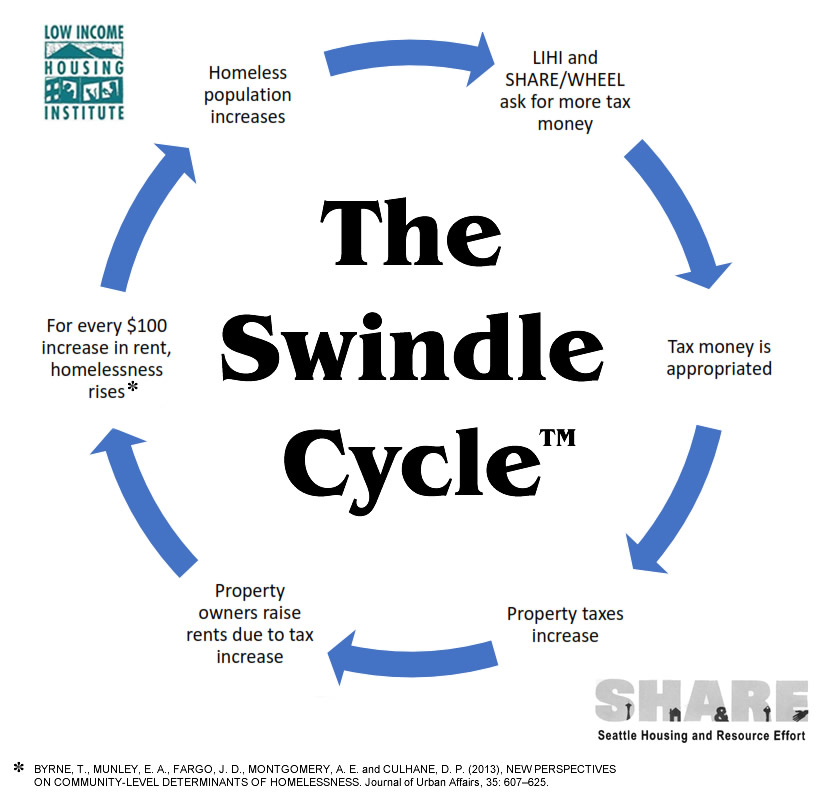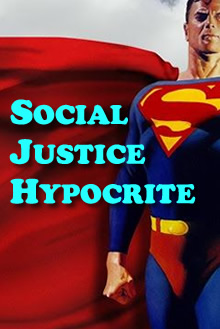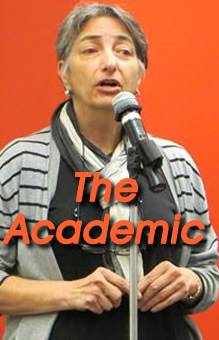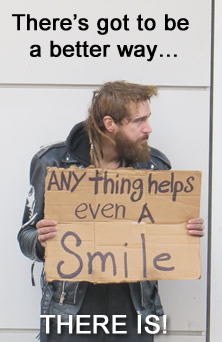February 4, 2018 ~ I have a friend, “Joe,” whose mind zips along at a hundred miles an hour. He’s always analyzing city politics and connecting the dots. On a typical day, he’ll send me a dozen e-mails with various insights and links to news stories he thinks I’ll like.
Today Joe sent me this diagram he made explaining how the Homeless Industrial Complex thrives off the homelessness that is manufactured, in a sense, by its own actions. I like this diagram very much, and I have dubbed it The Swindle Cycle™ in accordance with my theory that Seattle’s homeless “crisis” is in fact nothing more than that: one giant swindle.
Of course Joe’s diagram is an oversimplification; there are many other factors that affect the cycle – things like corrupt politicians, pressure groups, lazy news media, a distracted citizenry – but this diagram captures the process in its essentials.

One caveat I’d add is bear in mind that the Seattle-ites who get priced out of their homes due to tax increases and rent hikes* (center left position on the cycle) are not the same people we see living on the streets. In fact, they are not a significant part of the homeless population at all. A person doesn’t go from living in a pricey studio on Capitol Hill one month to being sprawled out under the viaduct with a needle in his arm the next, just because of a rent hike. But that doesn’t change the equation, because, as with any con game, it’s illusion that drives it and not reality. Yes, people ARE being priced out of Seattle; that’s a given. And yes we ARE seeing more homeless people on the streets than ever. The Homeless Industrial Complex wants us to conflate those two groups, and in the absence of any data proving that they are not the same – and there IS no such data, thanks to the efforts of Homeless, Inc. – people will assume that they ARE the same. Once that illusion has been implanted, Homeless, Inc. and their allies on the City Council can go to the good people of Seattle and say: “You’re doing so well here… but look, others are suffering! It’s your fault these people are on the street, so it’s your moral obligation to give us some of your money, so we can help them.” –Thus begins another round of tax hikes, rent increases, and price outs, and a new, even larger wave of vagrants hits the streets.
And so the swindle continues…
–David Preston and Joe
Also see my article “Anatomy of a Swindle” for more background on this.






















>>Seattle-ites who get priced out of their homes due to tax increases and rent hikes* (center left position on the cycle) are not the same people we see living on the streets.<<
So where do these people go, into the ether? Where is the data to support this ridiculous claim?
If you want to write a meaningful post, how about challenging the root cause of homelessness – our ruthless capitalistic economic system that exploits wage slaves until there is nothing left, and then disgards them (us) as refuge to be berated by assholes like you. Where is your outrage against our corporate overlords, plutocrats, and oligarchs? Do you support their endless greed?
I live outside because I can't afford the ridiculous rents in Seattle. But according to you, I don't exist. You're constantly attacking the victims of our extraordinarily corrupt system of greed and pretending as though you hold the moral high ground.
Until we address the root causes of homelessness, you can rant until you're blue in the face. If you want to effect real change, stop blaming the victims of corporate capitalism and turn your sights on the source of societies ills.
Great info and here is some to consider.
If just 35 of the 50 residents at Camp Second Chance in S Seattle are receiving Supplement Security Income (from the Social Security Administration for those unemployable) of $750 each per month, that is
$26, 250 per month X 12 months = $315,000 a year for their camp. Some of the residents may receive a higher Social Security Disability amount, or they may have wages that maybe higher than the SSI amount. But based on 35 people getting SSI alone they have more than covered their 2018 budget request of $269, 169 (as shown on the WS Blog). Food benefits would be another $197 per month per person if they only have SSI and no other income. If they pool their funds they have more then what they are asking for in their budget proposal.
Just read “anatomy of a swindle” and thank you for writing it. I love journalism that questions dogma — such as “all groups that help the homeless are good”. I wonder if you could shed some light on another bit of dogma – “seattle is attracting the homeless from other parts of the country”. It does seem from a recent NY Times article highlighting a homeless wedding in Seattle that all involved were either local volunteers or homeless who moved here for our state’s charity.
Hi, Pete. Thanks for the comment. To answer your question, I believe Seattle IS attracting “homeless” people from around the country. Other West Coast cities are, too. All these cities have two things in common: a mild climate and a tolerant attitude toward public vagrancy. I’m not going to let the rest of the country off the hook, though. Paradoxically, the places that are performing better on homelessness are contributing to the accumulation of vagrants elsewhere. Cities that take a hard line on vagrancy, by compelling vagrants to accept services or get out are causing their local service-resistant vagrants to flee and come to places like Seattle, where they can chill without being hassled. To address this, we need a more national approach to requiring vagrants and drug users to accept services like drug treatment and mental health care. When they realize that they’ll get the same response everywhere they go, they’ll be more likely to get indoors and into treatment. –David
Bill – They go to Mountlake Terrace, or Shoreline, or Monroe, or Edmonds, or one of the several hundred municipalities within 20 miles of Seattle.
I’d like to see the so-called data substantiating the claim that rising rents cause people to live on the streets (vs. relocating there residence to a lower cost area).
Not all that wind up without a place to live are a vagrant David, that word is getting thrown around too much. I’ve never begged in my life. And have had housing issues a couple times. I mean, c’mon man, I have one feeling left, dangling precariously by a thread above a pit of broken glass and sharpened spears tipped with poisen… spare me that one precious feeling, would you? 🙂
Bill Williams and David Preston are both right. David’s depiction of the swindle is pretty accurate. William’s assertion that crony capitalism and plutocrats are the root cause is accurate too.
As someone who has been advocating for people defending thier himes for over a decade, I can say the malfeasance, exploitation and fraud of banks has been a significant factor in our housing crisis. The foreclosures of tens of thousands of homeowners converted homeowners to home renters. This along with the rapid growth and nimby/GMA restrictions on building restricted supply. When demand exceeds supply costs/rents go up. People who cant keep up with or come up with first, last and deposit, and pass a credit check, end up homeless. People who lose jobs, homes and hope, sometimes turn to vices.
We must start getting real about the contributing factors.
Keep in mind, many who are part of the “swindle” here in King County were very well aware of the foreclosure fraud and did nothing to respond. One might think they wanted a crisis to use as an excuse to demand tax payer money to “solve” the problem.
All this to say the David’s and William’s of the world likely have more in common then different if they really take a look at the various contributing factors.
“The enemy of my enemy is my friend.”